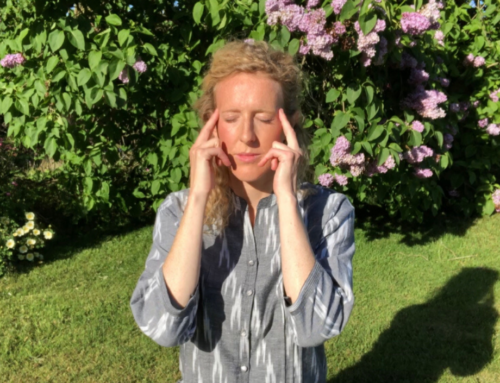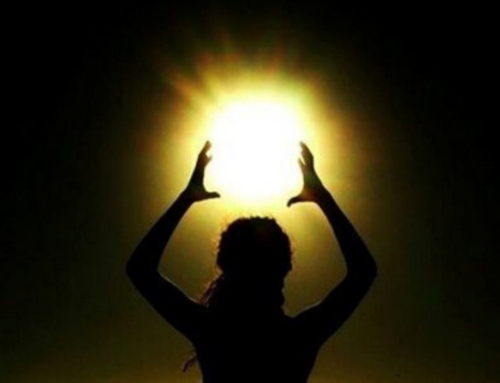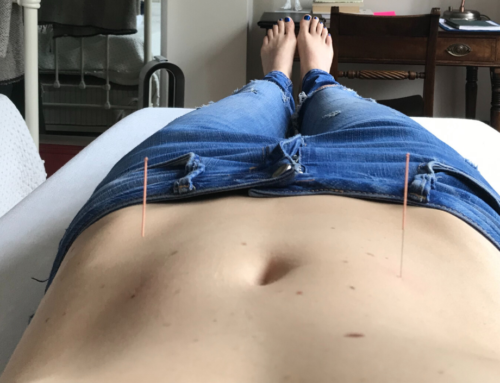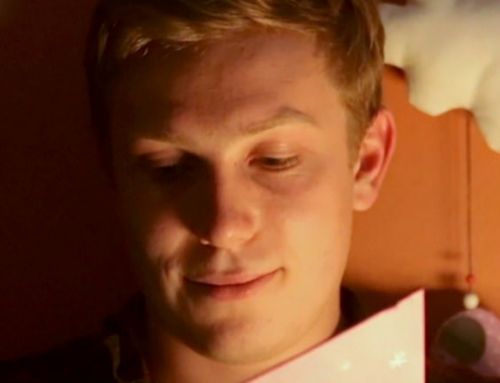Learning Traditional Chinese Medicine & Acupuncture from the masters in Shanghai
Ever since I set out studying Traditional Chinese Medicine (TCM) & Acupuncture, I’ve always wanted to learn at the source in China. So I was somewhat excited when I saw that Phoenix Medical was arranging a study internship in Shanghai in April 2019.
For a traditional acupuncturist like me, the chance to learn firsthand from the masters of Chinese medicine was like a dream come true as I knew there wouldn’t be many opportunities like this. So when April finally arrived, I packed my bags and headed to Shanghai, hungry for the precious knowledge that I knew awaited me.
The trip was beyond fascinating and inspiring. I got the chance to observe and help out in various clinics, primarily based at two hospitals – Longhua Hospital (Shanghai University of Traditional Chinese Medicine) and Shanghai Traditional Chinese Medicine Hospital. Here I had the pleasure of witnessing the wonderfully natural way that TCM and Western medicine are applied side by side, complementing each other.
I also attended lectures by leading professors, and visited a Moxibustion & Tui Na clinic, herb dispensaries, a Qi Gong centre and the Shanghai Traditional Chinese Medicine Museum. I even developed my Qi Gong skills, which are now a critical part of my day to ground myself and prepare for my patients.
I also became best friends with WeChat and Google Translate. Although I’m not 100% sure every translation was entirely accurate…
Anyway, here are some stories and photos from my trip.
Two Brits, one Vincentian, a Cypriot and two Russians
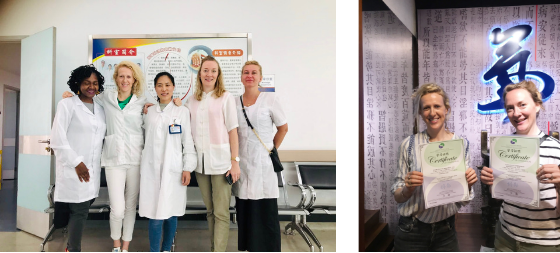
I was joined by six other practitioners for the internship. (That’s me in the photo – second from the left.) We were an eclectic bunch of acupuncturists, herbalists, massage therapists and yoga teachers from all over the world – two of us from the UK, and the others from St Vincent, Cyprus and Russia.
Distilling knowledge from Mandarin-speaking wizards
I quickly learnt that hardly anybody speaks English in Shanghai. Not even “hello” or “taxi”. Everyone speaks Mandarin, whether you’re on the street or in the hospital. Have you ever tried communicating via Google Translate? Because judging by some of the answers I got from the Chinese doctors, I was not always asking them what I thought I was…
This is actually one of the reasons I did an organised trip, because I knew the language barrier would be tricky. We were lucky to have translators with us for most of the trip, who made sure we could absorb every drop of knowledge from our teachers. A couple of the doctors did speak basic English, but there was nothing quite like being taught in Mandarin. It’s such an extraordinary and beautifully musical language which I will never comprehend.
Also, thankfully, the form of acupuncture they used was similar to the TCM style I studied at the College of Integrated Chinese Medicine in Reading. This meant that I could follow and learn what the doctors were doing, even if I couldn’t always understand what they were saying.
Observing the Chinese doctors at Longhua Hospital
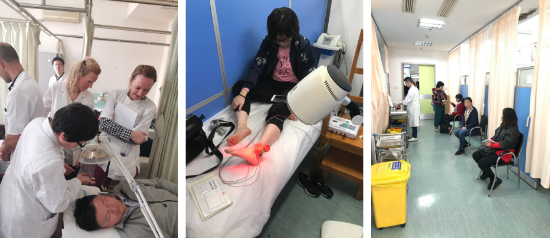
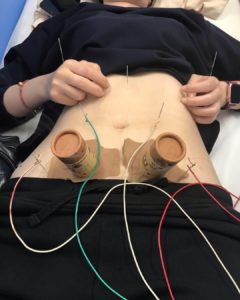
I spent the first part of my trip observing the doctors and assisting at Longhua Hospital.
This place uses a combination of Western and Chinese medicines. It has seven floors, covering oncology, digestive disorders, gynaecology, dermatology, urology, acupuncture and Tui Na (massage). Treatment includes acupuncture, herbal medicine, Western medicine, physiotherapy, diet therapy, Tui Na and Qi Gong.
I spent most mornings in an outpatient ward, where there was always a flurry of patients spilling through the ward door – most of which were basically told to pipe down and wait.
The ward had ten beds, separated by curtains – not dissimilar to a multi-bed clinic back in the UK.
Two doctors were on duty, rotating each day. I quickly learnt their routine. The doctors had a 3–5-minute consultation with each patient before treatment (nowhere near the hour I set aside for my initial consultations here). This leaves no time to get into emotions, precise detail nor which of the Five Elements the patient is.
Most patients in Longhua appeared to have similar treatment modalities, all tending to have electro-acupuncture (with an electric current between the needles), plus cupping (static or flash) as well as moxabustion too (either moxa burnt on a needle or in disposable moxa boxes).
The most common cases on the ward were facial paralysis, stroke, back pain, shoulder pain, knee pain, digestive issues and urinary incontinence. I wondered why there was so much facial paralysis. Almost every other patient had it. One doctor said it was because of the overuse of mobile phones; another said it was to do with wind and extreme changes in temperature – e.g. moving too suddenly from a hot shower into a cold, air-conditioned room. This sudden change in temperature can activate a latent virus (linked to the viruses responsible for cold sores, chickenpox, German measles, flu, mumps and hand-food-and-mouth disease).
From the short time I was at Longhua Hospital, I really grasped the TCM concept of wind being the spearhead of disease. The wind causes four seasons in one day out there. People can go from overheating one minute to being chilled to the bone the next.
Inspiring lectures on ancient needling techniques, the Eight Extraordinary Meridians and the Six Stages Model of TCM
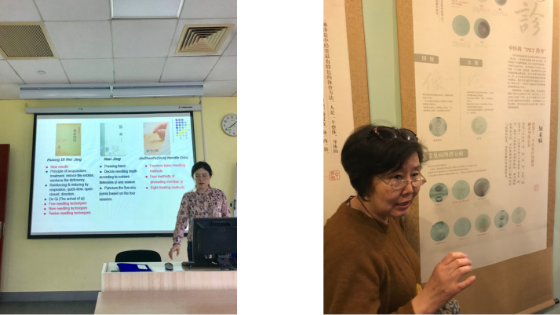

In the afternoons, we had lectures at Longhua Hospital and Shanghai University of Traditional Chinese Medicine by leading experts of Chinese Medicine.
I got to hear the masters of TCM speaking about ancient needling techniques, the Eight Extraordinary Meridians and the Six Stages Model of TCM.
In true Chinese style, the lectures started not a minute past the start time and often lasted for four hours, without any breaks (naturally meaning I drank half China’s supply of green tea).
The ancient needling techniques opened the door to another vast array of techniques that I didn’t even realise existed. The depth and rigour of the experts’ needle stimulation were second to none, with an eyewatering number of needles used and inserted without guide tubes.
Some of the techniques looked gruesome and painful but, due to the skill of the doctors, the patients barely flinched. Of course, it helps that Chinese Medicine is the primary option for Chinese patients, so they are more used to it and resilient than people back home in the UK.
From these lectures, I now have a much better grasp of how Chinese Medicine and disease relates to Western medicine. There is less of a disparity in China than the UK between the two medicines, as both are regularly used side by side in hospitals.
The Zhong Jing Tang Moxibustion, cupping and Tui Na clinic

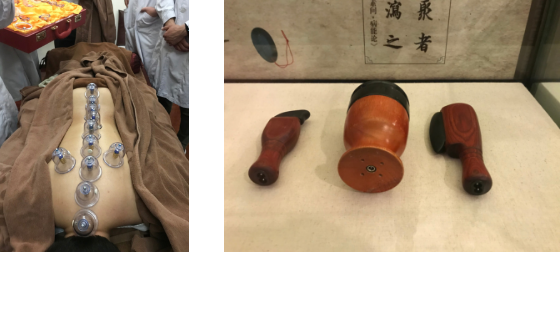
Once we’d finished at the hospitals, we were lucky enough to visit Zhong Jing Tang.
Zhong Jing Tang is an authentic moxibustion, cupping and Tui Na clinic in Shanghai. It uses ancient Tui Na Bian (massage) tools and various unique moxibustion methods I hadn’t seen before, including moxa stools, steam baths and hot-stone tables. The clinic have developed and made many of the Bian tools themselves.
They showed me how they use cupping as a way to diagnose patients. I was intrigued by this. I regularly use cupping as a treatment, but I’ve never used it as a method of diagnosing.
When it was my turn for cupping treatment, the suction of the cups created a dark colouring on my lower back. The therapist relayed this via Google Translate: “gynaecology issues – must not eat any ice and always sleep before 11pm.” Oh dear. Looks like I’m going to have to curb that ice-eating habit.
After this, I had an intense Tui Na treatment. I was amazed at how it created a powerful and positive shift in how I felt the next day. So much so that I have been researching and incorporating more Tui Na techniques into my treatments back home at my clinic.
Visiting a traditional Chinese herb dispensary
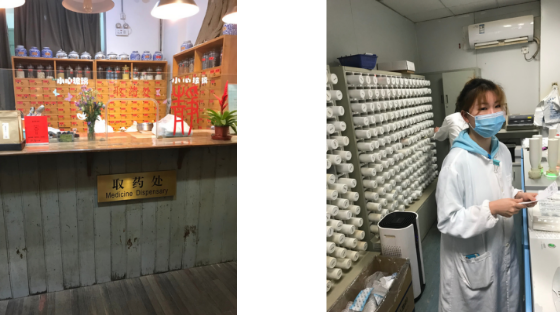
I went to a herb dispensary too (a vast pharmacy of Western and Chinese herbs and medicines). Although I don’t practise herbs (hopefully I will in time), visiting the dispensary gave me an insight into how Chinese doctors prescribe Western and Chinese medicine simultaneously. I also learnt about the remarkable power of herbs for treating skin, gynaecology and digestive conditions.
Check out my Qi Gong skills
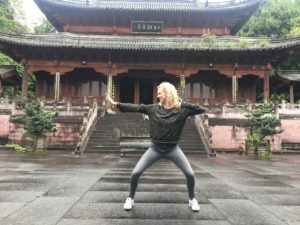
Once my time in Shanghai was over, I went to Linhai for the final few days of my trip, which was a four hour high-speed train trip south of Shanghai. As you can see, I got to learn Qi Gong in the most amazingly serene surreal surroundings.
This beautiful energy movement uses slow, flowing postures, breathwork and meditation. It has its roots in Chinese Medicine, and is used in China to cultivate balance, health and spirituality, as well as treat disease.
It’s the most mindful, grounding practise I’ve ever done, and is now part of my daily ritual. I truly believe it should be more accessible in the UK, as we are definitely missing a trick.
Lessons from a profound, energising trip
I can’t even begin to explain what a gift it’s been to learn from Shanghai’s top healers. I’d like to thank all the doctors, acupuncturists and herbalists (including Yi Song, Chao Chen and Saina Wang), Tui Na massage therapists (including Saina Wang), lecturers (including Fan Wang, Xueyong Shen and Fan Wu) and translators (including Yu Zhou). I’d also like to thank Shanghai University of Traditional Chinese Medicine and Phoenix Medical (including Laura Lam, George He) for arranging such an invaluable trip.
Learning from the masters in Shanghai has been invigorating. It has enabled me to consolidate my practise and thinking by witnessing the everyday application of traditional medicine in China.
For me, all great healing work revolves around a deep impulse to relieve others of pain, whether that’s using traditional medicine or Western therapy. The Chinese doctors see such positive results because they couple this with a clear insight into the nature of disease.
I’m going to keep studying and practising until I reach this level of sensitivity and understanding for all my patients. The plan is to return to the East one day to continue studying, but, until then, I’ll keep working on expanding my skills at home.
Would you like to try TCM and acupuncture or massage therapy?
I am always learning, deepening my understanding and adding to the therapies I offer.
As well as the internship at Shanghai University of Traditional Chinese Medicine this year, here are some of the courses I’ve completed in recent years:
Acupuncture Treatment of Acute Pain & Injury – Paul Kelly – 2019
Cosmetic Facial Acupuncture – Paul Adkins – 2019
Assessing & Treating Musculoskeletal & Sports Injuries with Acupuncture – Paul Blacker – 2018
Vipassana Meditation – Burgs – 2014 +2015
Diet in Clinical Practice – Daverick Leggett – 2014
Male & Female Infertility – Jill Glover – 2017
Electroacupuncture for Musculoskeletal problems – Stephen Lee – 2017
Indian Head Massage – 2015
Thai Yoga Massage – 2014
Pregnancy Massage – 2013
If you’d like to try TCM and acupuncture, or want to see if another therapy or technique is right for you, please do make an appointment. You can book online or contact me directly.
